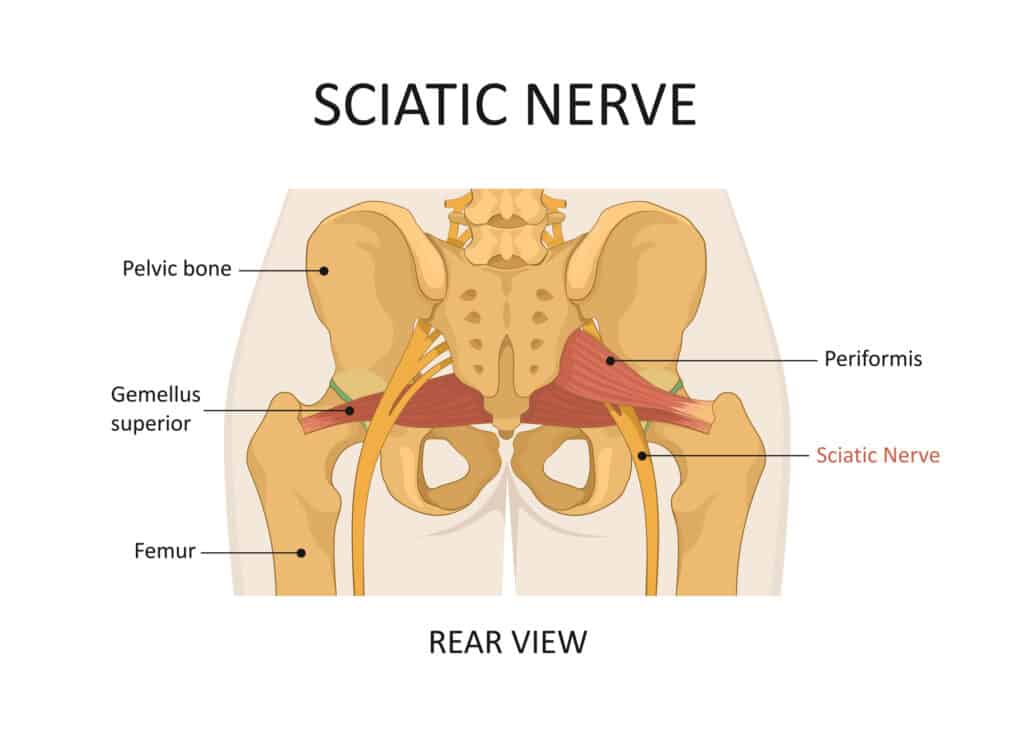
Do you experience shooting and burning pain from your lower back down your leg?
If so, you may be experiencing sciatic nerve pain. Pain can be such a pain. Whether it's a headache, a sore muscle, or a stiff joint, it can be challenging to focus on anything else while you’re experiencing discomfort.
Sciatic nerve pain occurs when the sciatic nerve is compressed, causing discomfort ranging from mild to severe.
While there are measures you can take at home, such as stretching and avoiding sitting for extended periods, it's essential to know when it's time to seek professional attention.
If your sciatica is causing intense pain, weakness, numbness in your legs, or difficulty controlling bladder or bowel movements, it's crucial to see an osteopath for help.
“Sciatica," as it's commonly called, is a common health issue affecting millions of people worldwide - but what causes it in the first place?
In this blog post, we explore some possible explanations for why you might have sciatic nerve pain and discuss various treatments that can help to relieve your symptoms.
It should give you a good idea of the symptoms to look out for when it comes to sciatic nerve pain, a deeper understanding of the different causes of sciatica, and, most importantly, how to prevent and manage the pain.
More Blogs From Osteoworks
How To Relieve Lower Back Pain
Thoracic Mobility is so Easy to Improve
Prevent lower-back injury with this simple routine 2021
Identifying Sciatic Nerve Pain Symptoms

Sciatic nerve pain can be pretty uncomfortable, disruptive, and downright painful.
Identifying your specific sciatic nerve pain symptoms – and whether they are, in fact, coming from your sciatic never or it's something else - can help you find the root cause and ultimately reduce the pain.
Some common symptoms to look out for if it is your sciatic nerve that is causing you problems include a tingling sensation or numbness in your lower back or buttocks, a sharp pain when you stand or sit, and weakness in your legs.
Do you have any of these symptoms?
What Are The Most Common Causes Of Sciatic Nerve Pain?

Sciatica is a pain you wouldn't wish on your worst enemy.
So, if you're experiencing intense pain, we know you're undoubtedly eager to get to the root of the issue and figure out what might be causing it.
But there are quite a few different factors that can play a role when it comes to this particular type of pain.
For example, some people experience sciatica due to a herniated disk in their spine, while others might be dealing with spinal stenosis or even a muscle spasm.
It can even be caused by something as simple as sitting for long periods, particularly if you’re sitting in a position that puts pressure on the sciatic nerve.
Whatever the cause, it's essential to identify it – with the help of a professional - so you can find the right treatment plan to help alleviate your pain and get back on your feet.
But some of the most common causes of this condition might surprise you:
Everyone knows a herniated disc can cause sciatica, but what about the lesser-known culprits? Like a tight piriformis muscle or pregnancy?
You heard that right. Pregnant women also commonly fall victim to sciatica. Even harmless behaviours, like wearing high heels, can contribute to the pain.
The bottom line is that sciatica is a sneaky type of pain with many potential causes.
How to Manage and Relieve Sciatic Nerve Pain

So, that shooting pain that travels down the back of your leg can be unbearable and make everyday activities a real challenge.
But the good news is that there are ways to manage and relieve sciatic nerve pain. From simple exercises to osteopathic treatment, many options are available to help you find some relief. So, don’t worry.
With some patience and persistence, it's possible to tame that stubborn sciatic nerve and whatever irritates it and get back to living a pain-free life.
With the right treatment and prevention tactics, you can find relief and keep sciatica from interfering with your daily life.
Firstly, in combination with osteopathic treatment, lifestyle changes can make a big difference in sciatic nerve pain and help reduce or even eliminate this pain. One such change is getting more exercise.
Exercise not only helps relieve pain but also strengthens your muscles, which can reduce the likelihood of future sciatic nerve pain.
Maintaining a healthy weight is also crucial, as extra body weight can put unnecessary pressure on the sciatic nerve, worsening the pain.
Regular exercise, especially low-impact workouts such as yoga and swimming, can help strengthen the muscles around the sciatic nerve, reducing the likelihood of compression.
Maintaining good posture and avoiding sitting for extended periods can also help, as it can cause the muscles to tighten and trigger pain.
Maintaining proper posture by relaxing your shoulder and aligning your spine can help reduce pressure on the sciatic nerve.
One of the worst feelings is having tension in your spine. It can make everyday tasks challenging and even ruin your mood. Fortunately, stretching exercises can help alleviate that discomfort.
One great exercise for this is the seated forward bend. This poses not only stretches your spine but also your hamstrings and calves.
Another exercise is the cat-cow stretch, which involves moving your spine through flexion and extension.
Yoga poses such as the downward-facing dog, and child's pose can also be beneficial in relieving tension along the spine.
Incorporating these stretches into your daily routine can help you improve your spinal health and reduce sciatic nerve-related discomfort.
Stretching exercises that strengthen the spine can also prevent further problems in the future.
Relaxing, reducing stress, and taking advantage of natural remedies such as hot/cold compresses or massage treatments can also be helpful. Regular massage increases flexibility and reduces tension around the sciatic nerve.
But if the pain persists, it is really important that you speak with an osteopath or other medical professional to get the help and treatment you might need for whatever is going on with your lower back and sciatic nerve. Please don't put it off.
How Can Osteopathy Help With Sciatic Nerve Pain?

If you’re struggling with unbearable sciatic nerve pain that negatively affects your daily life, osteopathy might be the answer for you.
Osteopathy is a type of holistic health care that focuses on treating physical ailments through targeted manual therapy and manipulation techniques to promote balance within your body's natural systems.
By addressing any blockages or disrupted joint functioning in the spine and its associated muscles, nervous system tissue can be cleared, allowing for a rebalanced musculoskeletal structure restoring proper motion and posture, which helps relieve pain.
It can help with sciatic nerve pain relief using various methods, including tone release technique, muscle energy technique, myofascial manipulation, and more.
Osteopathy provides an effective way to manage sciatic nerve pain. But it’s important to understand the cause and origin of your pain first.
Although we prefer not to use “labels” where possible. A proper diagnosis – or rather: root cause - is crucial for receiving successful treatment for any condition.
So, it’s important to find out whether your symptoms are coming from your sciatic nerve, and we can help you do that.
A correct diagnosis also gives you peace of mind, providing you with a better understanding of what’s going on and what you can do to manage it. It’s the foundation for any effective treatment plan.
Sciatica nerve pain typically presents as a sharp pain radiating from the lower back to the legs. Osteopathy can be a highly effective treatment option for this type of pain.
By manipulating your body's tissues, we can alleviate pressure on the sciatic nerve, reducing inflammation and relieving pain.
Unlike traditional physical therapists, we use a more holistic approach that views the body as a whole – not individual parts, addressing the root cause of the pain rather than just alleviating symptoms. We strongly emphasize the body's innate ability to heal itself.
So, osteopathy could be ideal for you if you're seeking a natural approach and lasting solution to sciatic nerve pain.
Osteopathic treatments can help reduce muscle spasms, repair tissue tears, and inflammation, and improve blood circulation along the sciatic nerve.
Our techniques are effective in relieving sciatic nerve pain specifically because we use non-invasive techniques that involve hands-on manual therapy to promote natural healing and improve mobility. The treatments we use can range from gentle stretches and massages to more advanced techniques such as spinal manipulation.
By addressing the underlying source of your pain, these techniques can provide long-lasting relief and help you reclaim your quality of life.
Our back pain specialists are ready and waiting to help you.
What are you waiting for?

